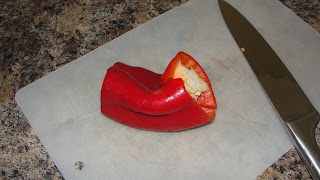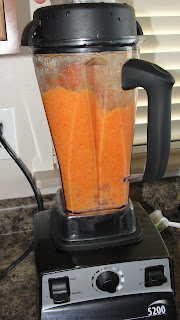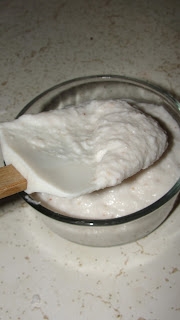Quinoa= "KEEN-wah". Use it as a 2 parts water to 1 part quinoa. 2:1 ratio.
Here is a great article to tell you a little more about Quinoa.
http://www.dietriffic.com/2010/06/24/what-is-quinoa/
I tend to do more "ishish" recipes, that empower the chef to be creative and rely on their own ability. SO... I normally do about a red pepper for every 4 cups of water (2 cups quinoa) I do. If it is not organic, make sure to give it a good wash and cut off the top and bottom. That is where most of the pesticides tend to hang out. Red peppers are on the list of the foods that have the most pesticides used on them. Here is a really good article about the "Dirty Dozen" and the "Clean 15".
2 cups of quinoa makes quite a bit, so we use any left over quinoa for the next couple of days over a salad for lunch. For just a dinner for two I would do 1 cup of quinoa and 2 cups water and a half of a pepper.
Blend the red pepper in water until a creamy consistency.
Pour into a saucepan.
It is not necessary to add anything else. The red pepper alone is enough seasoning, but I do like to add some other things once in a while. This time I happened to add some minced onion and parlsey. Some other nice additions may include: basil, Mrs Dash, cumin, garlic and about anything else you can think of. :):)
Bring to a boil on a little over medium heat.
While the red pepper liquid is being brought, ha ha is that even good english?, to a boil... grab out your quinoa. I buy quinoa in bulk and definitely keep it in the fridge. It as well as amaranth, millet and a few other things keep much better in the fridge. No fret though, I think it will stay unrancid in the pantry for about 6 months. I just don't like to take the chance, quinoa being over $3 a pound.
An up-close of this beautiful seed.
Pour your desired amount of quinoa into a bowl.
Add in water... it will be drained later and does NOT need to be measured.
This is a REALLY FUN part. Get your hands into it and act like you are giving it a massage. Grab the quinoa and grit it around in your hand, removing a bitter outer coating of the quinoa. Continue to do this for a minute or two.
Once that is complete, pour the quinoa into a thin mesh strainer...
Rinse the quinoa.
Then I just let it sit in the sink until the red pepper mixture is boiling.
Once brought to a boil, pour the quinoa into your saucepan. Turn the heat to about one notch under medium heat and it will take about 15-20 minutes, uncovered, to cook. Keep an eye on it and stir it every couple of minutes.
I tried to get pictures of the different phases as the quinoa cooks. Slowly the water will lesson and the quinoa fluffifies and expands.
Expanding more and getting fluffier.
Even fluffier. :)
I also decided to add some frozen corn at the very end of cooking. I don't really cook the corn, I just add it in at the last when the quinoa is about finished so the corn has enough heat to thaw.
Here she be! The finished product. We almost like it better cold over salad, but we love it warm too! Let me know if you have any questions!
Happy Quinoaing!!! There's some new "verbage" for you. :):):) Have the best day ever!!!!!!!!!!!!!!!!











































